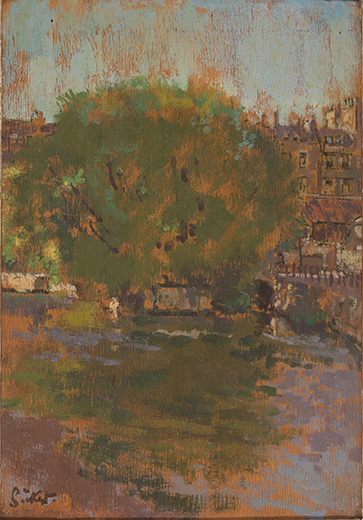Signed.
Literature: Baron
2006, p. 452, no. 492.12.
Provenance: Sir Hugh Walpole;
Purchased by H.E. Wortham at the 1952 exhibition;
Anonymous sale; Sotheby's, London, 8 March 1995, lot 17;
with Belgrave Gallery, London, 2005;
Anonymous sale; Sotheby's, London, 11 December 2006, lot 15;
Christie’s Sale, Modern British and Irish Art Day Sale, London, 26 June 2015, lot. 119.
Exhibitions: London, Leicester Galleries, The Collection of the late Sir Hugh Walpole, Part II, May 1945, no. 79, as 'Bath';
London, Leicester Galleries, Twentieth Annual Exhibition of Paintings, Drawings & Sculpture by Artists of Fame and Promise, July 1952, no. 57, as 'Bath'.
In this colorful and fresh painting, "built up in countless superimpositions of shaggy patchwork coats of paint", Sickert represented Pulteney bridge on the Avon, designed by Robert Adam in Palladian style and completed in 1771 (Baron 2006, p. 106). Perhaps for its "rich mixture of sky, water, vegetation and buildings", the bridge was one of Sickert's favourite subjects in Bath which he represented several times, depicting each version with "different points of cutting the scene" (Baron 2006, n. 492, p. 451). Sickert also decorated a Wedgwood teapot with a view of Pulteney bridge in 1922 (Baron 2006, p. 452).
Sold
